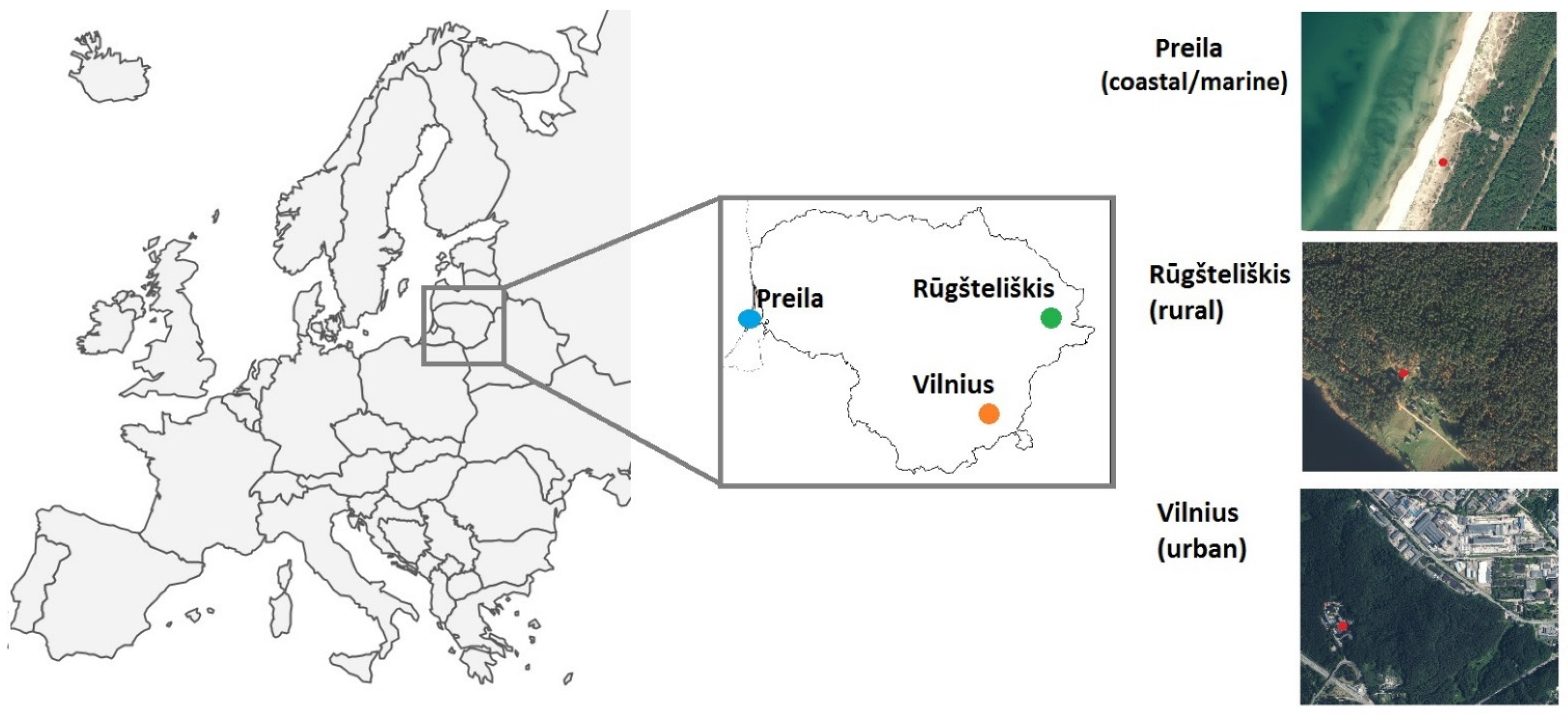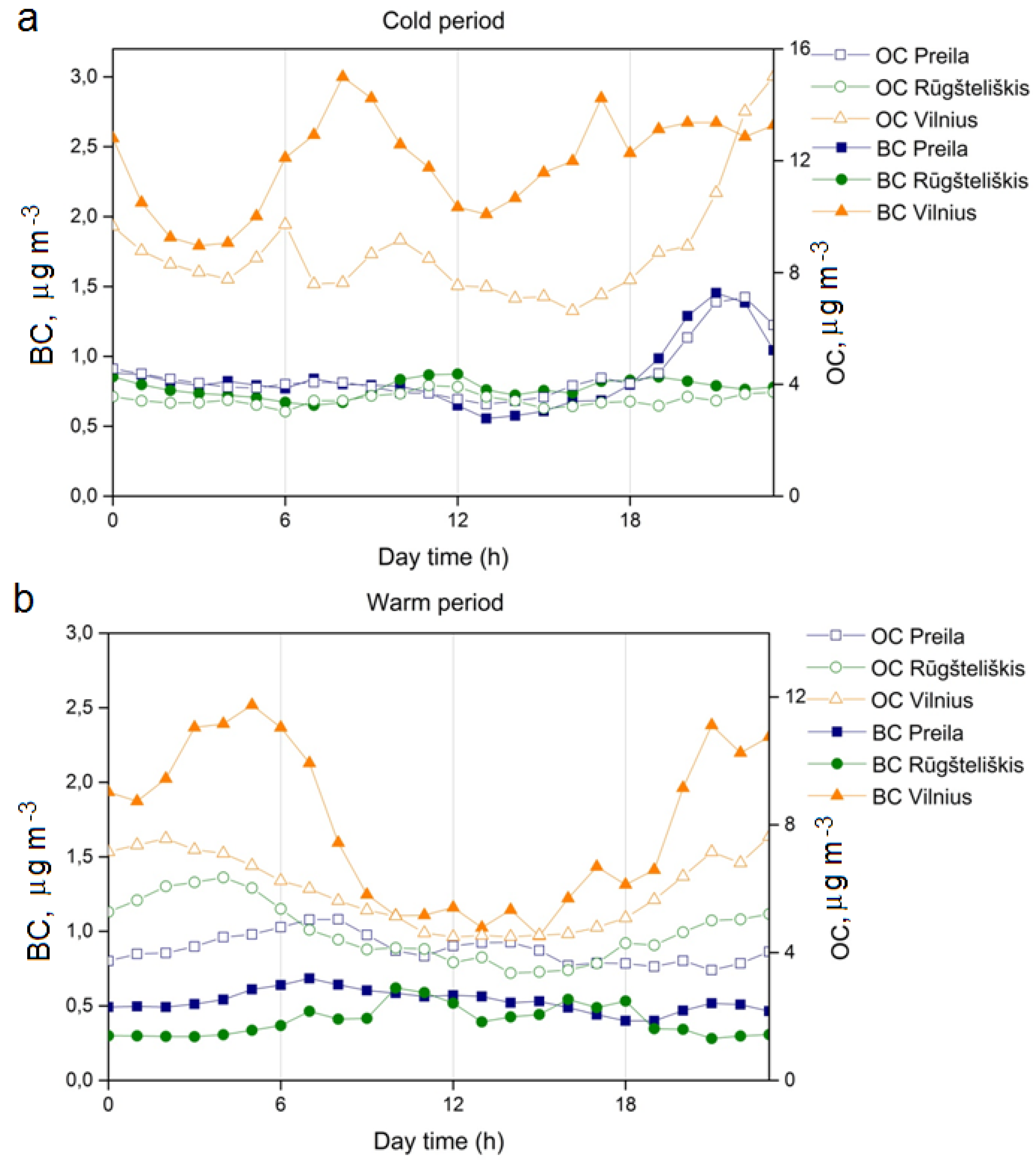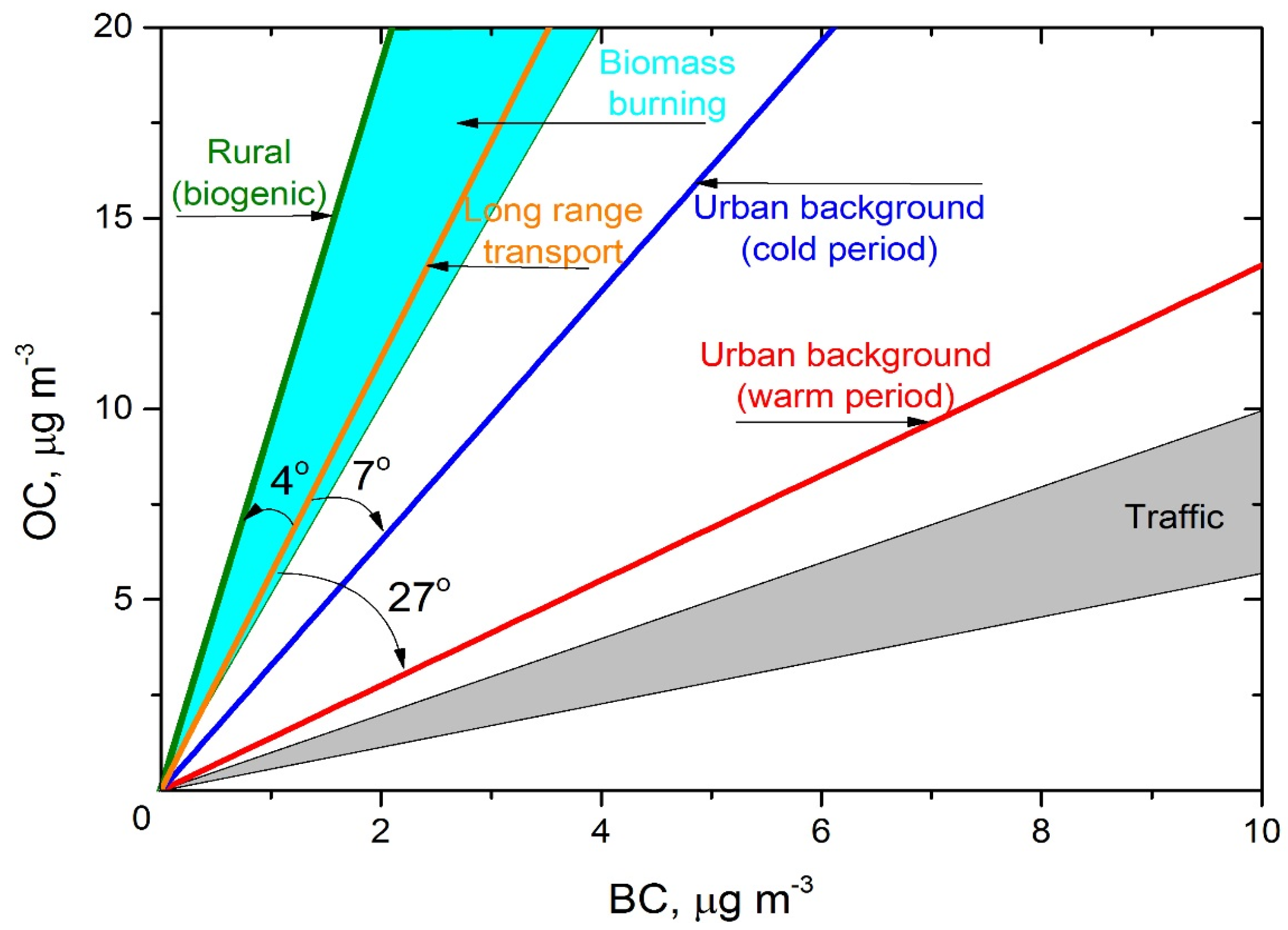Spatial and Temporal Analysis of Organic and Black Carbon Mass Concentrations in Lithuania
Abstract
:1. Introduction
2. Methods
2.1. Measurement Sites Description

2.2. Instrumentation
2.3. Air Mass Backward Trajectories
3. Results and Discussion
3.1. Seasonal and Diurnal Variations
| Location | Rugšteliškis | Preila | Vilnius | |||||||||
|---|---|---|---|---|---|---|---|---|---|---|---|---|
| BC | OC | BC | OC | BC | OC | |||||||
| Period | warm | cold | warm | cold | warm | cold | warm | cold | warm | cold | warm | cold |
| mean | 0.40 | 0.77 | 4.56 | 3.45 | 0.53 | 0.84 | 4.11 | 3.01 | 1.72 | 2.34 | 5.91 | 8.60 |
| st. deviation | 0.35 | 0.52 | 3.98 | 2.28 | 0.43 | 1.22 | 3.86 | 2.56 | 1.22 | 2.15 | 1.99 | 7.04 |
| min | 0.07 | 0.03 | 0.18 | 0.06 | 0.02 | 0.02 | 0.02 | 0.01 | 0.21 | 0.06 | 0.78 | 0.15 |
| max | 3.79 | 3.05 | 26.79 | 17.28 | 2.23 | 13.60 | 21.71 | 52.72 | 6.84 | 17.23 | 17.78 | 75.44 |

3.2. Case Studies: Impact of Long-Range Transport

3.3. Correlation between OC and BC

| Station type | Site | OC/BC (or OC/EC) | Calculated α in this study | Reference | ||
|---|---|---|---|---|---|---|
| Warm period | Cold period | Wam period | Cold period | |||
| Urban | Vilnius | 1.3 | 3.3 | 53° | 73° | (This study) |
| Birmingham | 2.1 | 65° | [3] | |||
| Helsinki | 1.7* | 2.2* | 59° | 66° | [32] | |
| Lisbon | 3.1 | 72° | [3] | |||
| Oporto | 2.0 | 63° | [3] | |||
| Rural | Rūgšteliškis | 9.5 | 4.3 | 84° | 77° | (This study) |
| Hyytiälä | 9.1* | 5.2* | 84° | 79° | [32] | |
| Lamas de Olo | 11.8 | 85° | [3] | |||
| Coastal/marine | Preila | 6.3 | 5.1 | 81° | 79° | (This study) |
| Areão | 7.3 | 4.0 | 82° | 76° | [34] | |
| Mace Head | 10.8 | 85° | [34] | |||

4. Conclusions
Acknowledgments
Author Contributions
Conflicts of Interest
References
- Jimenez, J.L.; Canagaratna, M.R.; Donahue, N.M.; Prevot, A.S.H.; Zhang, Q.; Kroll, J.H.; DeCarlo, P.F.; Allan, J.D.; Coe, H.; Ng, N.L.; et al. Evolution of organic aerosols in the atmosphere. Science 2009, 326, 1525–1529. [Google Scholar] [CrossRef] [PubMed]
- Satsangi, A.; Pachauri, T.; Singla, V.; Lakhani, A.; Kumari, K.M. Organic and elemental carbon aerosols at a suburban site. Atmos. Res. 2012, 113, 13–21. [Google Scholar] [CrossRef]
- Pio, C.; Cerqueira, M.; Harrison, R.M.; Nunes, T.; Mirante, F.; Alves, C.; Oliveira, C.; Sanchez de la Campa, A.; Artíñano, B.; Matos, M. OC/EC ratio observations in Europe: Re-thinking the approach for apportionment between primary and secondary organic carbon. Atmos. Environ. 2011, 45, 6121–6132. [Google Scholar] [CrossRef]
- Calvo, A.I.; Alves, C.; Castro, A.; Pont, V.; Vicente, A.M.; Fraile, R. Research on aerosol sources and chemical composition: Past, current and emerging issues. Atmos. Res. 2013, 120, 1–28. [Google Scholar] [CrossRef]
- Viana, M.; Maenhaut, W.; ten Brink, H.M.; Chi, X.; Wijers, E.; Querol, X.; Alastuey, A.; Mikuška, P.; Večeřa, Z. Comparative analysis of organic and elemental carbon concentrations in carbonaceous aerosols in three European cities. Atmos. Environ. 2007, 41, 5972–5983. [Google Scholar] [CrossRef]
- Kumagai, K.; Iijima, A.; Tago, H.; Tomioka, A.; Kozawa, K.; Sakamoto, K. Seasonal characteristics of water-soluble organic carbon in atmospheric particles in the inland Kanto plain, Japan. Atmos. Environ. 2009, 43, 3345–3351. [Google Scholar] [CrossRef]
- Salako, G.O.; Hopke, P.K.; Cohen, D.D.; Begum, B.A.; Biswas, S.K.; Pandit, G.G.; Chung, Y.-S.; Rahman, S.A.; Hamzah, M.S.; Davy, P.K.; et al. Exploring the variation between EC and BC in a variety of locations. Aerosol Air Qual. Res. 2012, 12, 1–7. [Google Scholar] [CrossRef]
- Seinfeld, J.H.; Pandis, S.N. Atmospheric Chemistry and Physics: from Air Pollution to Climate Change; John Wiley & Sons: New York, USA; p. 1326.
- Cyrys, J.; Heinrich, J.; Hoek, G.; Meliefste, K.; Lewne, M.; Gehring, U.; Bellander, T.; Fischer, P.; Van Vliet, P.; Brauer, M.; et al. Comparison between Different Traffic-related Particle Indicators: Elemental. Carbon (EC), PM2.5 Mass, and Absorbance. J. Exposure Anal. Environ. Epidemiol. 2003, 13, 134–143. [Google Scholar] [CrossRef] [PubMed]
- Ozdemir, H.; Pozzoli, L.; Kindap, T.; Demir, G.; Mertoglu, B.; Mihalopoulos, N.; Theodosi, C.; Kanakidou, M.; Im, U.; Unal, A. Spatial and temporal analysis of black carbon aerosols in Istanbul megacity. Sci. Total Environ. 2014, 473, 451–458. [Google Scholar] [CrossRef] [PubMed]
- Schleicher, N.; Norra, S.; Fricker, M.; Kaminski, U.; Chen, Y.; Chai, F.; Wang, S.; Yu, Y.; Cen, K. Spatio-temporal variations of black carbon concentrations in the Megacity Beijing. Environ. Pollut. 2013, 182, 392–401. [Google Scholar] [CrossRef] [PubMed]
- Dumka, U.C.; Manchanda, R.K.; Sinha, P.R.; Sreenivasan, S.; Moorthy, K.K.; Babu, S.S. Temporal variability and radiative impact of black carbon aerosol over tropical urban station Hyderabad. J. Atmos. Sol. Terr. Phy. 2013, 105, 81–90. [Google Scholar] [CrossRef]
- Hyvärinen, A.P.; Kolmonen, P.; Kerminen, V.M.; Virkkula, A.; Leskinen, A.; Komppula, M.; Hatakka, J.; Burkhart, J.; Stohl, A.; Aalto, P.; et al. Aerosol black carbon at five background measurement sites over Finland, a gateway to the Arctic. Atmos. Environ. 2011, 45, 4042–4050. [Google Scholar] [CrossRef]
- Saha, A.; Despiau, S. Seasonal and diurnal variations of black carbon aerosols over a Mediterranean coastal zone. Atmos. Res. 2009, 92, 27–41. [Google Scholar] [CrossRef]
- Clarke, A.D.; Shinozuka, Y.; Kapustin, V.N.; Howell, S.; Huebert, B.; Doherty, S.; Weber, R.; et al. Size distributions and mixtures of dust and black carbon aerosol in Asian outflow: Physiochemistry and optical properties. J. Geophys. Res. 2004, 109, D15S09. [Google Scholar]
- Kondo, Y.; Matsui, H.; Moteki, N.; Sahu, L.; Takegawa, N.; Kajino, M.; Brune, W.H. Emissions of black carbon, organic, and inorganic aerosols from biomass burning in North America and Asia in 2008. J. Geophys. Res. 2011, 116, D08204. [Google Scholar] [CrossRef]
- Ning, Z.; Chan, K.L.; Wong, K.C.; Westerdahl, D.; Močnik, G.; Zhou, J.H.; Cheung, C.S. Black carbon mass size distributions of diesel exhaust and urban aerosols measured using differential mobility analyzer in tandem with Aethalometer. Atmos. Environ. 2013, 80, 31–40. [Google Scholar]
- Byčenkienė, S.; Ulevicius, V.; Kecorius, S. Characteristics of black carbon aerosol mass concentration over the East Baltic region from two-year measurements. J. Environ. Monit. 2011, 13, 1027–1038. [Google Scholar] [CrossRef] [PubMed]
- Cape, J.N.; Coyle, M.; Dumitrean, P. The atmospheric lifetime of black carbon. Atmos. Environ. 2012, 59, 256–263. [Google Scholar] [CrossRef] [Green Version]
- Aruna, K.; Lakshmi Kumar, T.V.; Narayana Rao, D.; Krishna Murthy, B.V.; Suresh Babu, S.; Krishna Moorthy, K. Black carbon aerosols in a tropical semi-urban coastal environment: Effects of boundary layer dynamics and long range transport. J. Atmos. Sol. Terr. Phy. 2013, 104, 116–125. [Google Scholar] [CrossRef]
- Grivas, G.; Cheristanidis, S.; Chaloulakou, A. Elemental and organic carbon in the urban environment of Athens. Seasonal and diurnal variations and estimates of secondary organic carbon. Sci. Total Environ. 2012, 414, 535–545. [Google Scholar] [CrossRef] [PubMed]
- Wang, F.; Guo, Z.; Lin, T.; Hu, L.; Chen, Y.; Zhu, Y. Characterization of carbonaceous aerosols over the East China Sea: The impact of the East Asian continental outflow. Atmos. Environ. 2015, 110, 163–173. [Google Scholar] [CrossRef]
- Guzman-Morales, J.; Frossard, A.A.; Corrigan, A.L.; Russell, L.M.; Liu, S.; Takahama, S.; Taylor, J.W.; Allan, J.; Coe, H.; Zhao, Y.; et al. Estimated contributions of primary and secondary organic aerosol from fossil fuel combustion during the Cal-Nex and Cal-Mex campaigns. Atmos. Environ. 2014, 88, 330–340. [Google Scholar] [CrossRef]
- Huang, X.F.; Gao, R.S.; Schwarz, J.P.; He, L.Y.; Fahey, D.W.; Watts, L.A.; McComiskey, A.; Cooper, O.R.; Sun, T.L.; Zeng, L.W.; et al. Black Carbon measurements in the Pearl River Delta Region of China. J. Geophys. Res. Atmos. 2011, 116, D12208. [Google Scholar] [CrossRef]
- Rattigan, O.V.; Civerolo, K.; Doraiswamy, P.; Felton, H.D.; Hopke, P.K. Long term black carbon measurements at two urban locations in New York. Aerosol Air Qual. Res. 2013, 13, 1181–1196. [Google Scholar] [CrossRef]
- Byčenkienė, S.; Plauškaitė, K.; Dudoitis, V.; Ulevicius, V. Urban background levels of particle number concentration and sources in Vilnius, Lithuania. Atmos. Res. 2014, 143, 279–292. [Google Scholar] [CrossRef]
- Ulevicius, V.; Byčenkienė, S.; Remeikis, V.; Garbaras, A.; Kecorius, S.; Andriejauskienė, J.; Jasinevičienė, D.; Mocnik, G. Characterization of pollution events in the East Baltic region affected by regional biomass fire emissions. Atmos. Res. 2010, 98, 190–200. [Google Scholar] [CrossRef]
- Middlebrook, A.M.; Bahreini, R.; Jimenez, J.L.; Canagaratna, M.R. Evaluation of Composition-Dependent Collection Efficiencies for the Aerodyne Aerosol Mass Spectrometer using Field Data. Aerosol Sci. Techl. 2012, 46, 258–271. [Google Scholar] [CrossRef]
- Collaud Coen, M.; Weingartner, E.; Apituley, A.; Ceburnis, D.; Fierz-Schmidhauser, R.; Flentje, H.; Henzing, J.S.; Jennings, S.G.; Moerman, M.; Petzold, A.; et al. Minimizing light absorption measurement artifacts of the Aethalometer: evaluation of five correction algorithms. Atmos. Meas. Tech. 2010, 3, 457–474. [Google Scholar] [CrossRef]
- Rozwadowska, A.; Zielinski, T.; Petelski, T.; Sobolewski, P. Cluster analysis of the impact of air back-trajectories on aerosol optical properties at Hornsund, Spitsbergen. Atmos. Chem. Phys. 2010, 10, 877–893. [Google Scholar] [CrossRef]
- Draxler, R.R.; Rolph, G.D. HYSPLIT (HYbrid Single-Particle Lagrangian Integrated Trajectory) Model access via NOAA ARL READY Website 2015. Available online: http://ready.arl.noaa.gov/HYSPLIT.php (accessed on 5 August 2015).
- Aurela, M.; Saarikoski, S.; Timonen, H.; Aalto, P.; Keronen, P.; Saarnio, K.; Teinilä, K.; Kulmala, M.; Hillamo, R. Carbonaceous aerosol at a forested and an urban background sites in Southern Finland. Atmos. Environ. 2011, 45, 1394–1401. [Google Scholar] [CrossRef]
- Zappoli, S.; Andracchio, A.; Fuzzi, S.; Facchini, M.C.; Gelencsér, A.; Kiss, G.; Krivácsy, Z.; Molnár, Á.; Mészáros, E.; Hansson, H.C.; et al. Inorganic, organic and macromolecular components of fine aerosol in different areas of Europe in relation to their water solubility. Atmos. Environ. 1999, 33, 2722–2743. [Google Scholar] [CrossRef]
- Castro, L.M.; Pio, C.A.; Harrison, R.M.; Smith, D.J.T. Carbonaceous aerosol in urban and rural European atmospheres: Estimation of secondary organic carbon concentrations. Atmos. Environ. 1999, 33, 2771–2781. [Google Scholar] [CrossRef]
- Asmi, A.; Wiedensohler, A.; Laj, P.; Fjaeraa, A.M.; Sellegri, K.; Birmili, W.; Weingartner, E.; Baltensperger, U.; Zdimal, V.; Zikova, N.; et al. Number size distributions and seasonality of submicron particles in Europe 2008–2009. Atmos. Chem. Phys. 2011, 11, 5505–5538. [Google Scholar] [CrossRef] [Green Version]
- Novakov, T.; Menon, S.; Kirchstetter, T.W.; Koch, D.; Hansen, J.E. Aerosol organic carbon to black carbon ratios: Analysis of published data and implications for climate forcing. J. Geophys. Res. 2005, 110, D21205. [Google Scholar] [CrossRef]
© 2015 by the authors; licensee MDPI, Basel, Switzerland. This article is an open access article distributed under the terms and conditions of the Creative Commons Attribution license (http://creativecommons.org/licenses/by/4.0/).
Share and Cite
Pauraitė, J.; Mordas, G.; Byčenkienė, S.; Ulevicius, V. Spatial and Temporal Analysis of Organic and Black Carbon Mass Concentrations in Lithuania. Atmosphere 2015, 6, 1229-1242. https://doi.org/10.3390/atmos6081229
Pauraitė J, Mordas G, Byčenkienė S, Ulevicius V. Spatial and Temporal Analysis of Organic and Black Carbon Mass Concentrations in Lithuania. Atmosphere. 2015; 6(8):1229-1242. https://doi.org/10.3390/atmos6081229
Chicago/Turabian StylePauraitė, Julija, Genrik Mordas, Steigvilė Byčenkienė, and Vidmantas Ulevicius. 2015. "Spatial and Temporal Analysis of Organic and Black Carbon Mass Concentrations in Lithuania" Atmosphere 6, no. 8: 1229-1242. https://doi.org/10.3390/atmos6081229






